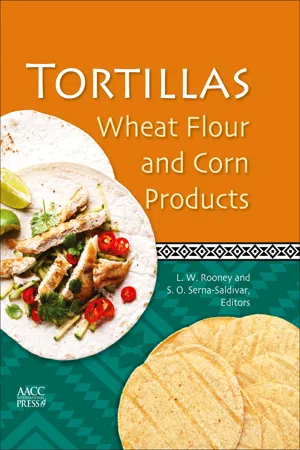
- English
- ePUB (mobile friendly)
- Available on iOS & Android
Tortillas: Wheat Flour and Corn Products
About This Book
Corn and wheat are among the most important cereals worldwide, representing many of the calories and proteins consumed. Tortillas and tortilla-related products are among the fastest-growing segments of the food industry and represent a sizeable portion of those calories.
Tortillas: Wheat Flour and Corn Products answers the food industry's need to meet the growing demand for high-quality tortillas and tortilla-based foods. This book will guide food scientists, product developers, and nutritionists through the fascinating science and technology behind the production of corn and wheat flour tortillas.
This title is the most comprehensive English-language book of its kind. It fully describes the technology, nutritional value, and quality control measures of corn and wheat flour tortillas, tortilla chips, and related products. It accomplishes this through 300 pages of quality text, complemented by easy-to-understand facts, figures, tables, and summaries that seamlessly guide users to an understanding of the fundamental underlying principles that optimize tortilla production and guide product development.
Tortillas: Wheat Flour and Corn Products is ideal for academics and industry professionals, including food science and nutrition students; people working in the tortilla and snack food industries; industry staff interested in the quality control/assurance aspects of tortillas; and professionals interested in cereal processing and product development. Edited by the renowned food science educators in tortilla production, this book provides high-quality training at both the academic and corporate levels
- A history of corn and wheat flour tortillas
- Ideal physicochemical properties of corn kernels and wheat flours to optimize processing
- Quality attributes of processed products and quality control/troubleshooting
- Food safety and quality control, from the raw materials to intermediate and finished products
- Various industrial setups and pilot plant techniques currently used to manufacture wheat flour tortillas
- Ideal physical, chemical, and rheological properties of tortilla flours
- Roles of leavening agents in tortilla quality
- Functions of dough emulsifiers and reducing agents in textural shelf life and "process-ability"
- Effects and roles of preservatives and supplemented enzymes on shelf life
- Common quality and consistency issues encountered by the flour tortilla industry, along with solutions and recommendations
- Optimum properties of corn kernels for tortillas and nixtamalized snacks, such as parched fried corn, corn chips, and tortilla chips
- Milling processes and quality control testing used to obtain lime-cooked dough, the backbone for the fabrication of table tortillas and corn and tortilla chips
Frequently asked questions
Information
History of Corn and Wheat Tortillas
SUMMARY
Agriculture in America
Table of contents
- Cover image
- Title page
- Table of Contents
- Copyright
- Dedication
- Contributors
- Preface
- Chapter 1: History of Corn and Wheat Tortillas
- Chapter 2: Nutrition and Fortification of Corn and Wheat Tortillas
- Chapter 3: Phytochemical Profiles and Nutraceutical Properties of Corn and Wheat Tortillas
- Chapter 4: Quality Assurance for Corn and Wheat Flour Tortilla Manufacturing
- Chapter 5: Processing of Flour Tortillas
- Chapter 6: Wheat Flour for Tortillas
- Chapter 7: Leavening in Flour Tortillas
- Chapter 8: Dough Conditioners in Flour Tortilla Processing
- Chapter 9: Preservatives: Extending Shelf Life and Shelf Stability
- Chapter 10: Enzymes: Extending Shelf Life and Eating Quality of Tortillas
- Chapter 11: Flour Tortilla Problems
- Chapter 12: Food-Grade Corn Quality for Lime-Cooked Tortillas and Snacks
- Chapter 13: Industrial Production of Maize Tortillas and Snacks
- Index